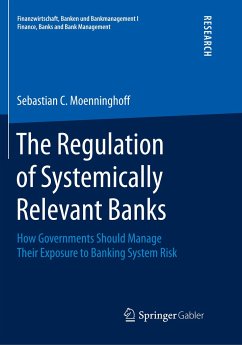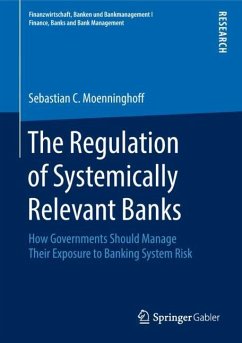
HRO Strategies for Resilient Risk Management in Banking
A Compound Integrative Risk Governance on the Management of Extreme Events
Versandkostenfrei!
Versandfertig in 6-10 Tagen
98,99 €
inkl. MwSt.

PAYBACK Punkte
49 °P sammeln!
This book introduces resilience-based concepts and high reliability organization (HRO) principles adapted from disruption-prone industries to improve risk management for tail or extreme events in U.S. globally systemically important banks (G-SIBs). HROs thrive in volatile environments by prioritizing adaptability, vigilance, resilience, and safety. Given that both G-SIBs and disruption-prone companies operate in increasingly uncertain and complex settings, there is a shared need for risk management techniques centered on resilience engineering to anticipate and mitigate unexpected extreme even...
This book introduces resilience-based concepts and high reliability organization (HRO) principles adapted from disruption-prone industries to improve risk management for tail or extreme events in U.S. globally systemically important banks (G-SIBs). HROs thrive in volatile environments by prioritizing adaptability, vigilance, resilience, and safety. Given that both G-SIBs and disruption-prone companies operate in increasingly uncertain and complex settings, there is a shared need for risk management techniques centered on resilience engineering to anticipate and mitigate unexpected extreme events. While G-SIBs are too big to fail and provide valuable insights into resilience in high-stakes scenarios, these approaches can benefit banks of all sizes facing similar risks.
The book explores the social world of banking and management, emphasizing the subjective nature of risk as people interpret events differently. Through surveys, interviews, and case studies, the research identifies growing interest in non-predictive risk methods for bank resilience. It recommends supplementing existing quantitative risk models with a transdisciplinary approach focused on non-predictive HRO principles to help banks prevent and mitigate extreme risks. The study finds that current G-SIB risk methods rely heavily on quantitative models, which may create a false sense of security. Additionally, extreme events are increasingly compound and often driven by human behavior. The book targets scholars and professionals seeking advances in resilience engineering within banking.
The book explores the social world of banking and management, emphasizing the subjective nature of risk as people interpret events differently. Through surveys, interviews, and case studies, the research identifies growing interest in non-predictive risk methods for bank resilience. It recommends supplementing existing quantitative risk models with a transdisciplinary approach focused on non-predictive HRO principles to help banks prevent and mitigate extreme risks. The study finds that current G-SIB risk methods rely heavily on quantitative models, which may create a false sense of security. Additionally, extreme events are increasingly compound and often driven by human behavior. The book targets scholars and professionals seeking advances in resilience engineering within banking.












